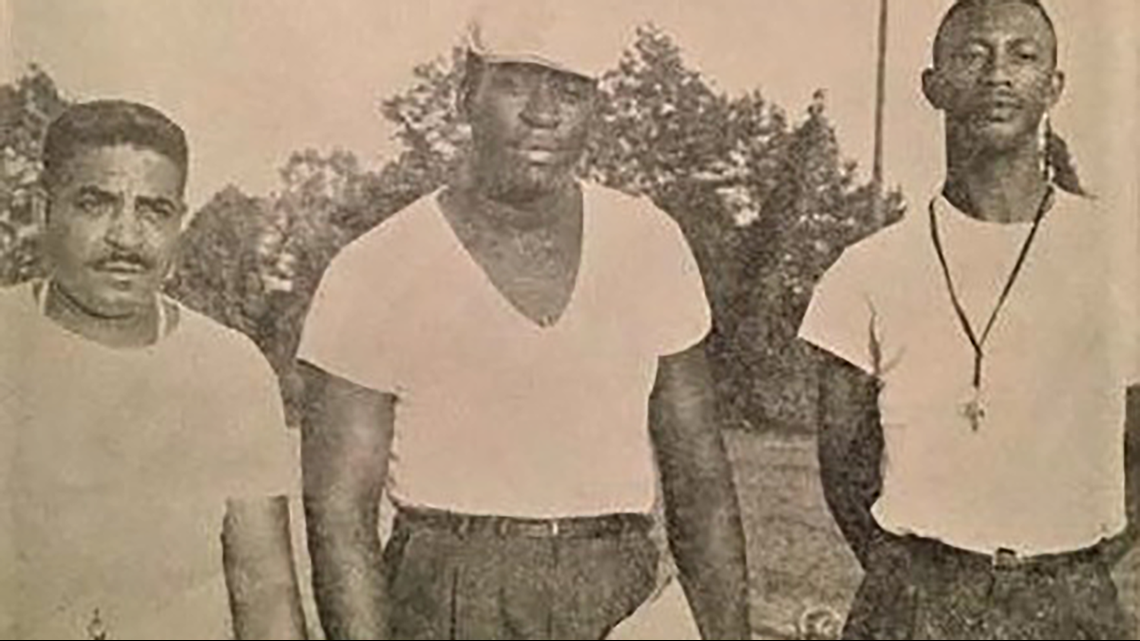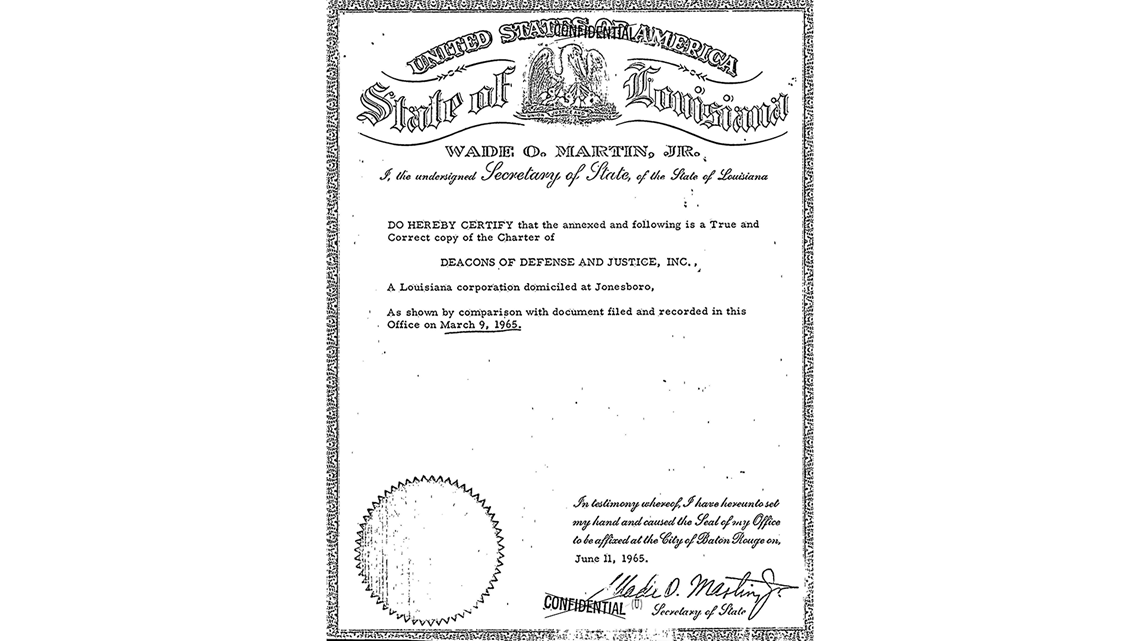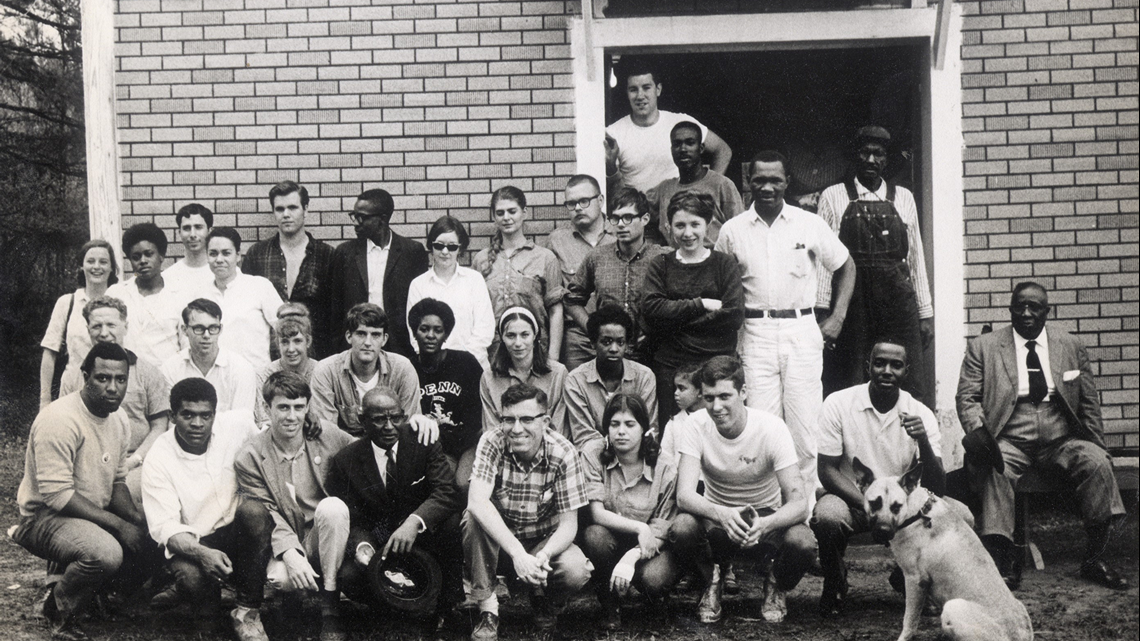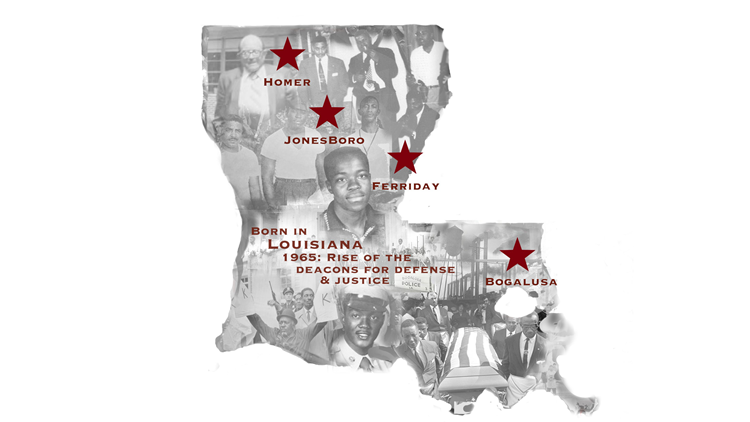JONESBORO, La. — On a July night in Jonesboro in 1964, the rumble of engines encroached on a quiet, black neighborhood then known as “The Quarters.” As residents stepped out onto their porches, they observed a line of cars—maybe 50 in all—with two to four men in each vehicle, their faces covered by white hoods.
As the Ku Klux Klan motorcade, lit up by the assistant chief of police car in front, paraded through the neighborhood, the intruders jeered and cursed. In their wake, sheets of paper fluttered through the air before settling onto the unpaved road. Alarmed parents instructed their children to stay inside and away from windows.
Once the cars moved on, neighbors gathered the litter from the streets. The KKK leaflets threatened retaliation if African-Americans engaged with the Congress of Racial Equality (CORE), a civil rights group that assisted black communities with voter registration and integration of public facilities.
A mill town in Jackson Parish, Jonesboro is located at the center of north Louisiana. Its economy a half-century ago was fueled by the timber industry, paper and sawmills, as well as a canning company. In 1964, as Jackson Parish native Jimmie Davis completed his final term as governor, the parish population stood at about 16,000. Over a fourth of the residents lived in Jonesboro. The town was founded during the Civil War, and in the years afterward the Jim Crow mentality was firmly established.
CORE arrived in Jonesboro earlier in this “Freedom Summer” of 1964. The activists busied themselves organizing voter registration drives from within the confines of black churches. They also joined demonstrations to desegregate public accommodations, such as the restaurants and the community swimming pool. CORE’s presence, as well as the enactment of the Civil Rights Act of 1964, moved racial tensions to a new height.
Alarmed by the motor parade and the threat against CORE, black residents ran back to their homes to retrieve their shotguns and pistols. Some stayed behind to defend their property, while another group headed to the Freedom House, CORE’s lodging, and stood guard until daylight. The Klansmen did not return that night.
Klansmen were wrong to think that their motorcade and threats would cower the black community. Instead, hundreds of black residents crammed wall-to-wall onto the second floor of their Masonic Hall building, the KKK leaflets clenched tight into their fists.
The cold hard facts were clear: If cops were supporting the Klan’s attempt to intimidate black neighborhoods, the citizens could only rely on themselves for protection.
TIME TO TAKE A STAND
One attendee at this meeting was Rev. Frederick Douglass Kirkpatrick. Named after the abolitionist, Kirkpatrick was a force in both stature and ambition. He stood tall at 6-feet-4-inches and weighed 260 pounds.
Formerly a football star at Grambling University, Kirkpatrick in 1964 was the gym and football coach at Jackson High School, the segregated black school in Jonesboro. The students nicknamed him “Boogie Chillen” because he carried his guitar around the school and played songs during classroom breaks.


In the years ahead, Kirkpatrick would pursue a career in folk music, singing about civil rights while also leading demonstrations around the country. In 1972, he recorded his own song, “The Deacons,” which detailed the meeting in the Masonic Hall, the moment when a group of black men realized it was time to take a stand against the violence.
This birth of the Deacons for Defense and Justice in Louisiana came at a time when Rev. Martin Luther King Jr. was preaching non-violent civil disobedience. However, Klan violence against black neighborhoods in rural areas like Jonesboro was ramping up with frequent cross burnings, arsons, harassment and murder. Armed self-defense seemed like the only option, and the Deacons may have been the first, and certainly became the largest, group in Louisiana to espouse this view.
The rise of the Deacons is painted vividly in FBI documents obtained through the Freedom of Information Act by the LSU Manship School of Mass Communication’s Cold Case Project. The 606-page file had never been released publicly, and it makes clear that the Deacon’s intention was never to provoke violence or fire the first shot but just to ward off violence.
Six months after the Masonic Hall meeting, in January 1965, Jonesboro CORE Representative Charles Joseph Fenton advised an FBI agent of the establishment of the Deacons. For the first time, the organization was on the radar at the bureau, which was closely monitoring Klan activities. A young, white New Yorker thirsty to make a difference, Fenton had taken on the role as liaison between CORE and the Deacons, his trusty dog Duffy by his side.
Fenton explained that the Deacons had “purposes much the same” as CORE. However, according to an FBI summary of the interview, Fenton also said the group was “more militant than CORE and that it would be more inclined to use violence in dealing with any violent opposition encountered in civil rights matters.” He added that armed Deacons patrolled and defended the black section of Jonesboro at night.
The Deacon files, coupled with other FBI documents compiled by the LSU Cold Case Project over the years, show the rise of KKK activity in the state, including the formation of the Original Knights in Shreveport-Bossier in 1960 and the intrusion of the United Klans of America, based in Alabama, in 1963.
In March 1965, according to FBI files, a United Klans unit from Monroe arrived in Jonesboro with plans to retaliate against civil rights activists wanting to integrate the white high school. Local Klansmen sometimes asked out-of-town units to handle certain projects. Targeted in Jonesboro were the black high schools, CORE headquarters and black neighborhoods.


But when the Monroe Klansmen made it to Jonesboro, they were greeted by three police officers, including the sheriff, who warned them to abandon their project because the FBI was aware of their plans. Also alerted was James Malcolm Edwards, a chiropractor in Jonesboro, who was named Grand Dragon (or statewide president) of the Louisiana Realm of the United Klans of America in late 1964.
Situations like these were among reasons the Deacons were desperately needed. As Kirkpatrick’s song notes,
“That is why the Deacons was born,
“To protect our families and our home
“Protect the lives of those that aren’t born
“For decent homes and schools,
“and to fight against Jim Crow Rules
“That is why the Deacons was born.”
A TRIP TO BOGALUSA
FBI agents also interviewed other Deacons, and Kirkpatrick told them that the Deacons worked “for the good of all people.” The word “deacon,” he said, reflected a position of leadership within the church, and the word “defense” signaled that they were peaceful but would “protect and defend themselves when necessary.”
Kirkpatrick’s song lyrics explain:
“Let’s call ourselves the Deacons
“And they will have no fear.
“They’ll think we’re from the church
“… And geez to our surprise, it really worked!”
Using their own guns, the Deacons communicated with walkie-talkies and citizen band radios. They stood guard during demonstrations and marches to the courthouse. At night, they patrolled black neighborhoods to defend against troublemakers.
The Deacons counted about 30 members. Olen Satcher worked with Kirkpatrick at Jackson High School as the assistant football coach and driver’s education teacher. Henry Amos owned a service station. The treasurer, Cosetta Jackson, was an elderly cab driver who encouraged passengers to register to vote. Army Johnson owned Johnson’s Joy Room, a facility that featured a café, skating rink, barbershop, boarding house and a washateria.


A man had to be at least 21 to join the Deacons, be respected in the black community and pay dues and other fees totaling $35 annually. These funds paid for pamphlets, radio equipment and charity donations and provided black residents with legal assistance during trials.
Soon, the Deacons began helping other Louisiana towns where public officials had looked away while the Klan attacked blacks with impunity.
Kirkpatrick’s song told the story:
“We went throughout the lands,
“Setting up chapters on every hand
“We had our Bibles on our knees.
“Oh, you good Christians!
“I know you don’t understand
“Why we’re handing out 38s to our band.”
In late February 1965, shortly before the Deacons filed formal papers with the Louisiana Secretary of State to become a nonprofit organization, Kirkpatrick and other members of the Jonesboro group visited Bogalusa. Deacon's Vice President Earnest “Chilly Willy” Thomas, as well as Fenton and another CORE activist, William Yates, also went to Washington Parish. There, they met with the Bogalusa Voters and Civic League. Their discussion centered on establishing a Deacons chapter in Bogalusa, the second of what would become four chapters in Louisiana.


The visitors outlined the organizational structure of the Deacons. According to an FBI summary of the meeting, Thomas advocated establishing a code system “through radio communication in which if one community needed help, Deacons from other communities could come assist.” Thomas asserted that the group required high-caliber weapons and ammunition by the case to fight Klansmen and white segregationists who resorted to violence.
He stressed that the Deacons had no intention of “starting anything” but would “combat violence with violence.” According to the FBI’s summary, he also said that “roving patrols were needed in trouble spots to assist blacks being arrested or attacked by police. If officers saw armed Negroes, they would back off.”
Thomas then made a claim so dubious and dangerous that a memo landed on the desk of FBI Director J. Edgar Hoover. According to the FBI’s summary, “Thomas said that his group has contacts in Chicago and Houston for automatic weapons and mentioned a .50 caliber and .30 caliber machine gun.”
This alarmed top FBI officials because they could see that Bogalusa was a powder keg. Given the turmoil during marches, counter-marches and Klan attacks, the bureau feared a Deacons chapter in Bogalusa would ignite a war with the Ku Klux Klan. Thomas’ claims of amassing weapons reaffirmed this fear.
In response, FBI headquarters instructed agents in Louisiana to “immediately initiate an intensive investigation” of the Deacons “because of the potential for violence indicated.” The bureau ordered its New Orleans field office to be “alert for indications of subversive and/or outside influence,” to determine whether the organization was spreading to other towns and to investigate Thomas’ claims that he had weapons contacts in Chicago and Houston.
Thomas’ militant speech was a double-edged sword. Taking on the self-serving role of the organization's spokesman, he was traveling around the country by that June spreading news of the group. Articles about the Deacons popped up in national newspapers, including the Los Angeles Times and The New York Times.
Thomas embellished the Deacon’s accomplishments, chapters, and membership. He claimed that there were up to 55 Deacons chapters in the U.S. It was an enormously inflated number, but Thomas’ fib served a purpose. It helped him raise money and potentially deterred attacks in communities believed to have had a Deacons presence.


LIVES CHANGED; LIVES SAVED
A week later, after a second meeting in Bogalusa, the Jonesboro Deacons were on their way home in a Ford station wagon when they realized armed whites were tailing them. During a high-speed chase of up to 110 miles per hour, the pursuers eventually backed off once the Deacons reached a bridge over the Mississippi River.
But there was trouble in Jonesboro, too, and one incident highlights the Deacons’ policy of fighting violence with violence.
After leaving a CORE meeting at the Johnson Joy Room, Deacon Elmo Jacobs offered a lending hand to a CORE student volunteer from Kansas, who had run out of gas. As Jacobs drove to his home to retrieve a gas can, a brown station wagon pulled ahead of his vehicle. At that moment, a white man pointed a single-barrel shotgun out the window and opened fire. The bullets pounded the metal of Jacobs’ car.
Fearing for his life, Jacobs brandished his 38-caliber pistol and fired—one—two—three—four shots in return. No one was hit. But following Deacon policy, Jacobs, in self-defense, had fought violence with violence.
According to FBI records, officers who served the Jonesboro Deacons were Percy Lee Bradford, president; Earnest Thomas, vice-president; Frederick Douglass Kirkpatrick, secretary; Cosetta Jackson, treasurer; and Allen Scherrah, financial secretary. Members included Henry Collins Amos, Otis Martin, Olen Satcher, Elton Lee Patterson, Charlie White, Elmo Jacobs, Harvey Barnes, Edd Barnes, Jesse Lewis, Rudolph Patterson, Hose Barnes, W. C. Flanagan, J. B. Bolds, John Jackson, Johnny Bonier, Asper Reed, Frank Bolds, Joseph Doyle, Edgar Joe, Harvey Johnson, Rev. Sanders Thompson and Army Johnson.



